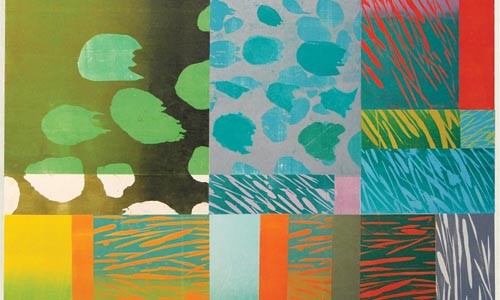A long-haired, girlish-looking self-portrait of Naoko Matsubara greets visitors entering the Carnegie Museum of Art's Scaife Works on Paper Gallery. The affectionate gaze of the Japanese-born, Canadian printmaker is directed not toward visitors, but down the three long galleries displaying an overview of her life's work. Understandably so: Organized by the museum's assistant curator of fine arts, Amanda Zehnder, Matsubara: A Celebration in Pittsburgh is a 60-work, 50-year tribute to the artist.
Born in Kyoto in 1937, the daughter of an eminent Shinto priest, Matsubara began printmaking in 1957 under the tutelage of designer Felice Rix. A member of the Viennese School of Applied Arts, and the wife of Japanese architect Isaburo Ueno, Rix instilled an affinity for unconventional technique, a trait evident in Matsubara works like "Peacock" (1962). The print's vibrantly plumed bird was created by pressing ink-covered leaves to paper.
Another vital period in Matsubara's creative life began with her 1960 Fulbright Fellowship, which brought her to the Carnegie Technical Schools (the forerunner of CMU). She earned her MFA there in 1962. While in Pittsburgh, Matsubara documented Pennsylvania winters, Mount Washington precipices and Westinghouse assembly lines, treating them with the same gravitas she brought to iconic places of worship, like "Chartres" (1963) and "Kenkun Shrine" (1966).
By the mid-1960s, Matsubara was working as a studio assistant to exiled German illustrator Fritz Eichenberg. Echoes of Eichenberg's expressionist style surface in works like "Nishiki Market" (1977), from Matsubara's Kyoto series, where the predominant color is black, grocer signs are painstakingly incised and receding perspective is expressed as a pile-up of vendor stands.
An extension of the Carnegie retrospective -- titled Matsubara: Illuminations and appearing at Chatham University Art Gallery -- features the artist's vibrant watercolor scrolls and original woodblock illustrations, displayed beside the books in which they appear. Through works like Matsubara's 1961 portrait of a sitar-bearing "Ravi Shankar," and the 1965 polychrome "Moon Messengers," curator Sandy Kita connects pictograms in Matsubara's native language to her representational style. Both works balance printed and unprinted space, and Kita, a Chatham senior scholar, contends that words influenced Matsubara's movement toward abstraction.
The 1970s and '80s were decades of further experimentation for Matsubara, who began to gravitate toward solid color fields beneath complicated block prints. In "Rain" (1971), part of the Walden-inspired Solitude series and displayed at the Carnegie, a Kelly-green field with diagonal slashes indicating a downpour underlies a large, heavily textured black frog. Matsubara revisits the design in 1987 with "Amagaeru," this time focusing on bold color and abstract contour.
A 1986 trip to Tibet transformed Matsubara's perception of space and color. Her experience gave birth to the 10-year, 27-work Tibetan Sky series. "Ah, Tibet" and "Tibetan Sky, A" (1987) reveal a willingness to explore complex decorative pattern and unusual hue juxtapositions, like red and turquoise, ochre and navy, aqua and white. The series permanently unfetters color in Matsubara's work.
While Matsubara's most recent works appear entirely liberated from figurative obligations, titles anchor them to the representational world. "Summer Garden A" (2007) and "Summer Garden B" (2008) show Matsubara moving toward an aesthetic wedding of Matisse's late-career paper collages and Barnett Newman's laconic color-field paintings.
Composed of many smaller prints, which form larger harmonious assemblages of color and pattern, the resulting works are enormous in scale. They involve both print and collage techniques, and preclude mechanical replication -- as indicated by the "1/1" run-numbering at the lower left corner of each.
A retrospective by such a prolific artist requires incisive curatorial vision. To choose works that best reveal this fundamental aesthetic progression, one must perceive the developmental core that shapes a larger oeuvre. Yet Matsubara is more than a chronological record of stylistic permutations. It is also an illustrated biography: a vivid portrait of a productive career, its related peregrinations and the mind at its helm.
Matsubara: A Celebration in Pittsburgh (Carnegie Museum, 4400 Forbes Ave., Oakland; 412-622-3131) and Matsubara: Illuminations (Chatham University Art Gallery, Chatham campus, Shadyside; 412-365-1140). Both continue through June 7.















